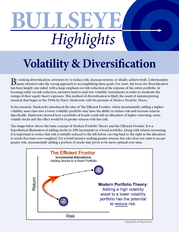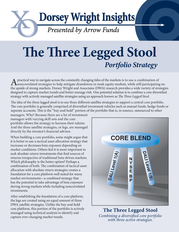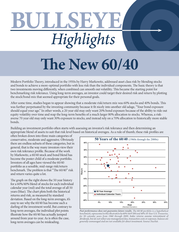Description
While the markets have viewed Harvard and Yale’s portfolio
changes as cutting edge, the endowment managers were really
just putting into practice the evolving theories on asset allocation
taught in their respective universities.
The Unconventional Approach
How diversified have endowment holdings become? Today,
many large university endowments are allocating between
10% and 20% to absolute return strategies. Likewise, these
endowments have also reduced their fixed income exposure.
Why? Absolute return strategies are designed to respond in all
market conditions. While bonds provide some support during
down markets, they typically do not participate equally when
the markets are strong. This may explain why Harvard and Yale
continue to reduce their exposure to fixed income instruments.
use of stocks, bonds and cash, often in the form of mutual
In his book Unconventional Success, Yale’s David Swensen offers
advice for the average investor.
Swensen argues that an investor has three levers over investment performance: asset allocation, portfolio strategy and security selection. portfolio diversification is through asset allocation. For years, individuals have been managing their investments with the funds. This conventional approach provides a limited degree of benefit, but lacks a tactical element—which is why the conventional approach is no longer used by professionals, such as those managing university endowments. Access to the strategies used by university endowments have historically been unavailable to many individual investors and seemed to be reserved for use by hedge funds and institutions. But today’s investors finally have access to a wide array of tactical and alternative investment mutual funds and ETFs. By combining traditional investments with alternative assets, individual investors can now create tactical asset allocation To paraphrase Swensen’s main points: strategies similar to the sophisticated approach of the investment management teams at Harvard and Yale. l Asset allocation—include six core asset classes in your portfolio: domestic equity, foreign developed equity, emerging market equity, real estate, U.S.
Treasury bonds, and U.S. Treasury inflation-protected securities. l Portfolio strategy—rebalance your portfolio annually, While many individuals lack the time or experience to implement these strategies on their own, there are now mutual funds that can do it for them. With relatively lower employing a strategy capable of making short-term bets against long-term asset allocation targets. l Security selection—buy low cost index funds or exchange traded funds; avoid hedge funds and corporate bonds. costs compared to hedge funds, mutual funds provide the access, liquidity and professional management that investors want—providing a conventional solution for an unconventional approach. RETURN The chart to the right illustrates the goal of Endowment Allocation strategies—to improve on the limitations of the traditional Efficient Frontier by reducing risk and increasing returns. It is common knowledge that one of the best ways to achieve 100% Equity Alternative Assets 100% Bonds RISK Performance displayed represents past performance, which is no guarantee of future results. The information provided here is for informational purposes only, is not intended as investment advice and should not be construed as a recommendation with regard to investment decisions.
Source for data, charts and graphs: National Association of College and University Business Office, Yale University Annual Report and Harvard University Annual Report, calculated by Arrow Investment Advisor, LLC. The material provided herein has been provided by Arrow Investment Advisors and is for informational purposes only. Arrow Investment Advisors serves as investment advisor to one or more mutual funds distributed through Northern Lights Distributors, LLC (member FINRA).
Northern Lights Distributors, LLC and Arrow Investment Advisors are not affiliated entities. 1157-NLD-8/11/2010 .
Swensen argues that an investor has three levers over investment performance: asset allocation, portfolio strategy and security selection. portfolio diversification is through asset allocation. For years, individuals have been managing their investments with the funds. This conventional approach provides a limited degree of benefit, but lacks a tactical element—which is why the conventional approach is no longer used by professionals, such as those managing university endowments. Access to the strategies used by university endowments have historically been unavailable to many individual investors and seemed to be reserved for use by hedge funds and institutions. But today’s investors finally have access to a wide array of tactical and alternative investment mutual funds and ETFs. By combining traditional investments with alternative assets, individual investors can now create tactical asset allocation To paraphrase Swensen’s main points: strategies similar to the sophisticated approach of the investment management teams at Harvard and Yale. l Asset allocation—include six core asset classes in your portfolio: domestic equity, foreign developed equity, emerging market equity, real estate, U.S.
Treasury bonds, and U.S. Treasury inflation-protected securities. l Portfolio strategy—rebalance your portfolio annually, While many individuals lack the time or experience to implement these strategies on their own, there are now mutual funds that can do it for them. With relatively lower employing a strategy capable of making short-term bets against long-term asset allocation targets. l Security selection—buy low cost index funds or exchange traded funds; avoid hedge funds and corporate bonds. costs compared to hedge funds, mutual funds provide the access, liquidity and professional management that investors want—providing a conventional solution for an unconventional approach. RETURN The chart to the right illustrates the goal of Endowment Allocation strategies—to improve on the limitations of the traditional Efficient Frontier by reducing risk and increasing returns. It is common knowledge that one of the best ways to achieve 100% Equity Alternative Assets 100% Bonds RISK Performance displayed represents past performance, which is no guarantee of future results. The information provided here is for informational purposes only, is not intended as investment advice and should not be construed as a recommendation with regard to investment decisions.
Source for data, charts and graphs: National Association of College and University Business Office, Yale University Annual Report and Harvard University Annual Report, calculated by Arrow Investment Advisor, LLC. The material provided herein has been provided by Arrow Investment Advisors and is for informational purposes only. Arrow Investment Advisors serves as investment advisor to one or more mutual funds distributed through Northern Lights Distributors, LLC (member FINRA).
Northern Lights Distributors, LLC and Arrow Investment Advisors are not affiliated entities. 1157-NLD-8/11/2010 .
Asset Management Presentations
+
Asset Management Sub Categories














